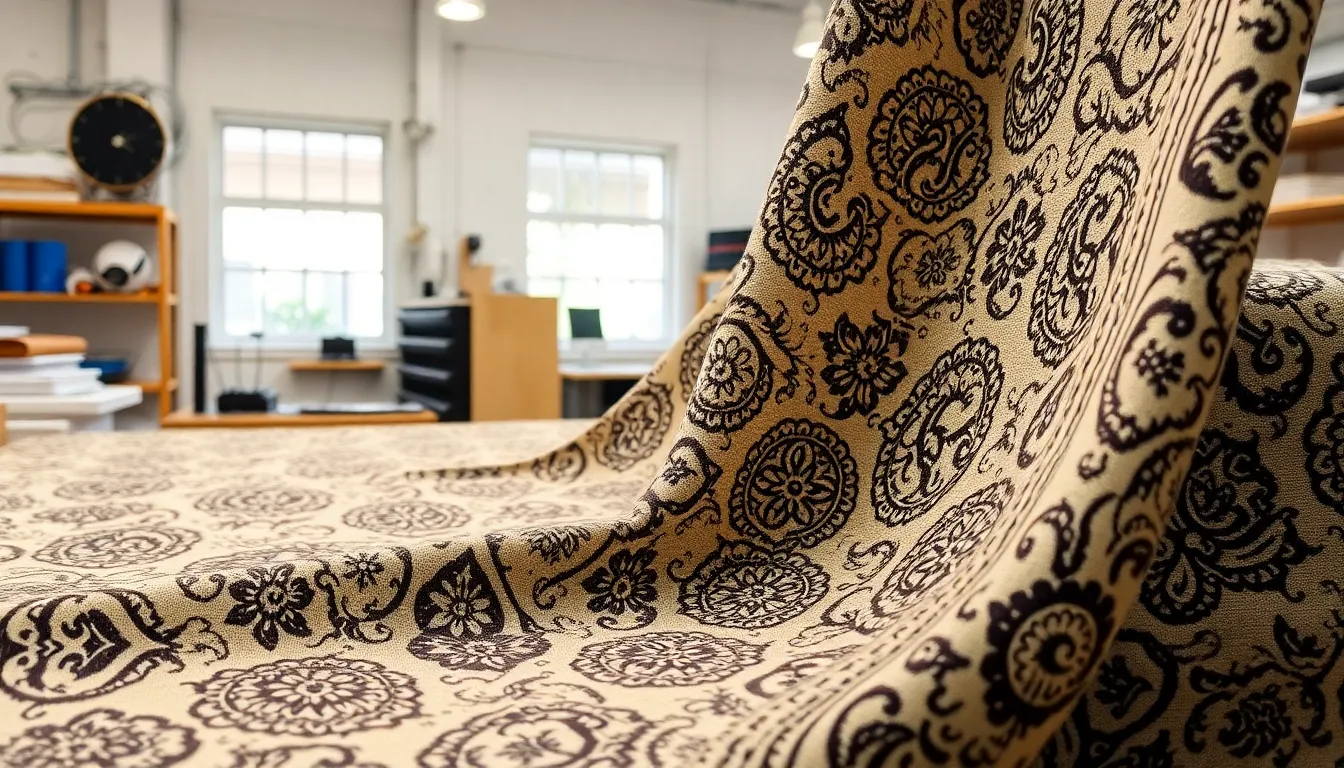Table of Contents
ToggleThe textile sector is like a chameleon—always changing and adapting to the whims of fashion, technology, and consumer preferences. From sustainable fabrics that make Mother Nature smile to high-tech textiles that could make even Iron Man jealous, this industry is buzzing with innovation. If you think textiles are just about clothes, think again. They’re weaving their way into our homes, cars, and even the gadgets we can’t live without.
Overview of Textile Sector Trends
Textile sector trends reflect a rapidly changing landscape influenced by multiple factors. Sustainability continues to gain traction, with many brands focusing on eco-friendly materials and production methods. Innovations in technology also enhance fabric functionality, allowing for moisture-wicking, temperature control, and even smart textiles that interact with the environment.
Fashion trends play a pivotal role in shaping consumer preferences, prompting the rise of digital platforms that enable quick realization of designs. Increased awareness of ethical sourcing has led consumers to seek out companies that prioritize transparency in their supply chains.
Textiles now extend well beyond traditional apparel. Various sectors, including automotive and home decor, integrate advanced textiles to improve aesthetics and functionality. The integration of performance fabrics into everyday items demonstrates versatility, with applications in sports, outdoor gear, and workwear.
In addition, the market sees a growing interest in local manufacturing, driven by a desire for unique products and faster delivery times. E-commerce platforms facilitate direct connections between consumers and manufacturers, allowing for greater customization and responsive service to specific demands.
Data highlights the importance of digital innovation in textiles, with a projected market growth rate of 4.4% from 2021 to 2028 according to industry reports.
Overall, the textile sector adapts constantly, emphasizing a blend of sustainable practices, technological advancements, and heightened consumer engagement. The evolution of this sector positions it as a critical player in the global economy, influencing diverse aspects of lifestyle and functionality.
Current Market Dynamics

The textile sector is evolving rapidly, reflecting shifts in consumer preferences and technological advancements.
Consumer Preferences
Sustainability influences purchasing decisions significantly. Many consumers actively seek eco-friendly materials and ethical sourcing practices. Trends show a growing demand for transparency in supply chains. In addition, personalization becomes increasingly important; shoppers favor brands that offer customization options. Digital platforms play a crucial role, allowing consumers to engage directly with manufacturers. Research indicates that 66% of global consumers are willing to pay more for sustainable brands. Consequently, these preferences push brands to adopt responsibility in production methods.
Technological Advancements
Innovation drives market dynamics in textiles. Smart textiles, which incorporate technology to enhance functionality, attract attention. Features like moisture-wicking and temperature control transform how consumers view fabric performance. Additionally, digital printing technology allows for faster and more efficient design processes. Brands leverage automation to streamline production, reducing lead times and costs. Data shows that investment in textile technology is expected to reach $10 billion by 2025. As a result, these advancements significantly improve both product quality and consumer satisfaction.
Sustainability in Textiles
Sustainability stands at the forefront of the textile sector, reflecting consumer priorities and industry commitments.
Eco-Friendly Materials
Innovations in eco-friendly materials offer sustainable alternatives to traditional textiles. Organic cotton, hemp, and recycled polyester have gained traction for their reduced environmental impact. Many brands now produce fabrics using non-toxic dyes and low-water processes, minimizing pollution. Additionally, biodegradable fibers like Tencel and Lyocell contribute to a closed-loop system, significantly lowering waste. Research shows that 66% of global consumers actively seek brands committed to sustainable practices. As a result, the demand for these eco-conscious materials continues to rise, reshaping industry standards.
Circular Fashion
Circular fashion promotes a sustainable lifecycle for textiles, emphasizing reuse and recycling. This model encourages brands to create designs with longevity in mind, reducing the frequency of disposal. Innovations like take-back programs enable consumers to return used garments for recycling or repurposing. Additionally, technologies such as garment-to-garment recycling have emerged, allowing worn-out items to transform into new fabrics. Reports indicate that a circular economy in fashion could generate an additional $560 billion by 2030. Adopting circular fashion principles accelerates the shift towards sustainability in the textile industry.
Innovations Shaping the Future
Innovations are transforming the textile sector, driving both sustainability and efficiency. Key trends emerge as companies leverage technology to meet evolving consumer demands.
Smart Textiles
Smart textiles incorporate technology into fabrics, enabling interaction with their environment. These innovative materials include sensors that monitor health metrics or adjust temperature based on the wearer’s needs. For example, textiles may feature moisture-wicking capabilities that enhance comfort. Increasing interest in smart textiles reflects consumer preferences for multipurpose garments. Companies are investing significantly in this sector, as the potential market for smart textiles is projected to reach $3.7 billion by 2025.
Digital Manufacturing
Digital manufacturing revolutionizes traditional production methods within the textile industry. 3D printing technology allows brands to personalize designs rapidly while minimizing waste. Additionally, automated processes streamline manufacturing, reducing lead times and costs associated with traditional practices. Adoption of on-demand production meets the rising demand for unique consumer offerings. Research indicates that companies embracing digital manufacturing can achieve up to 50% lower material costs. Overall, these advancements contribute to a more sustainable and efficient textile sector.
Regional Insights
The textile sector demonstrates distinct trends across different regions, shaping its future.
Emerging Markets
Emerging markets lead the textile industry by embracing eco-friendly production. Countries like India and Bangladesh are shifting toward sustainable practices fueled by consumer demand for ethical products. In these nations, traditional textiles combine with modern technologies, enhancing functionality while preserving cultural heritage. Research underscores that 66% of global consumers actively seek brands committed to sustainability, driving substantial growth in these markets. Additionally, local artisans and designers are gaining global recognition for their unique contributions to sustainable fashion. Investments in education and technology further bolster the textile industry’s capacity to innovate, positioning these emerging markets as vital players in creating a sustainable future.
Established Markets
Established markets, particularly in North America and Europe, focus on advanced textile innovations. Brands within these regions prioritize smart textiles that enhance functionality through technology integration, addressing consumer preferences for performance-driven materials. Research predicts that the market for smart textiles could reach $3.7 billion by 2025, reflecting the growing importance of these innovations. Furthermore, sustainability remains key, with many companies committed to transparent supply chains and eco-friendly practices. European legislation increasingly promotes circular fashion, encouraging brands to design for longevity and to implement recycling initiatives. Adaptations in production processes, influenced by digital manufacturing, reduce waste and costs, ensuring established markets stay competitive while meeting evolving consumer demands.
The textile sector is on an exciting trajectory marked by sustainability and innovation. As brands embrace eco-friendly materials and ethical practices, they’re not only meeting consumer demands but also paving the way for a more responsible industry. The rise of smart textiles and digital manufacturing is transforming traditional processes, enhancing functionality while reducing waste.
With consumers increasingly prioritizing sustainability and personalization, the industry is adapting rapidly. Emerging markets are leading the charge in eco-friendly production, while established regions focus on advanced technologies. The continuous evolution of the textile sector underscores its significance in the global economy and its commitment to a sustainable future.





